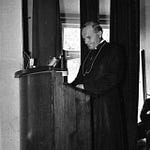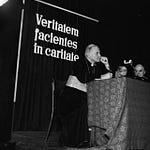Following the publication of Veritatis Splendor, critics immediately focused on its second chapter, with its emphasis on intrinsically evil acts. Indeed, this focus was important, because Pope John Paul II saw the need to recapture the sense of sin that had gone lost in the Church. However, thee Pope’s primary concern was not simply to set up rules or cold, hard criteria for sin and how to avoid it. His concern, which is constant throughout his writing, is the love of God made incarnate in Christ and his gift of himself.
It is in the Crucified Christ that the Church finds the answer to the question troubling so many people today: How can obedience to universal and unchanging moral norms respect the uniqueness and individuality of the person and not represent a threat to his freedom and dignity? (Sec. 85)
We recall that in chapter 1 of the encyclical, John Paul II had pointed to the Lord’s encounter with the rich young man and Christ’s invitation,
“come, follow me.” He returns to that theme and amplifies it, pointing to Jesus’s total gift of himself on the cross. This is his invitation to us — to share in his total gift of self. This is the key to moral theology, which is not about rules and penalties. It is about love. It is about bearing witness to truth. Therefore, Pope John Paul II turns inevitably to the witness of the martyrs, beginning with the story of Susanna (Daniel 13). They show forth the dignity and inviolability of the person, “on whose face is reflected the splendor of God.” (Sec 90)












Share this post